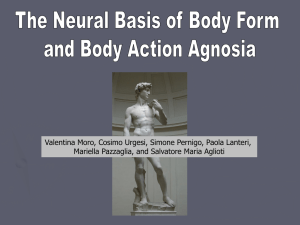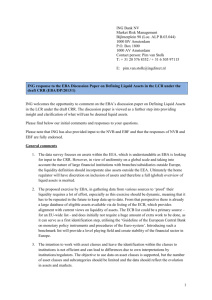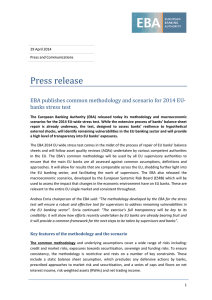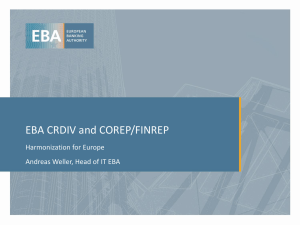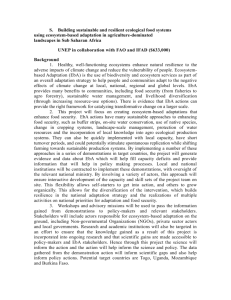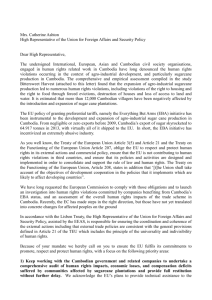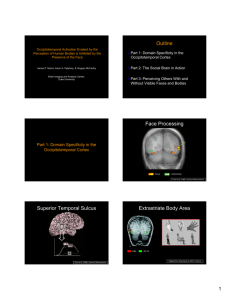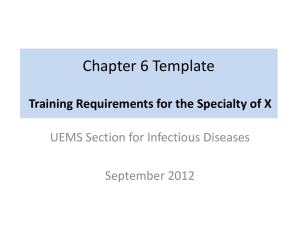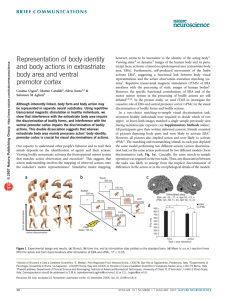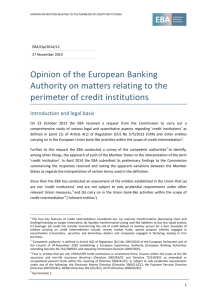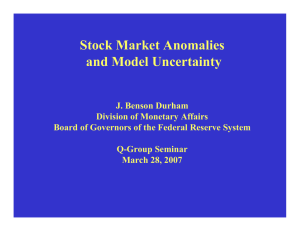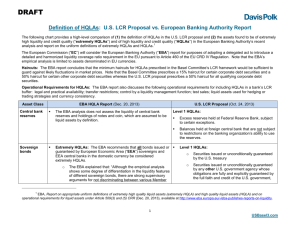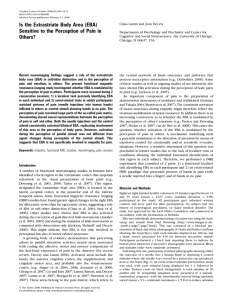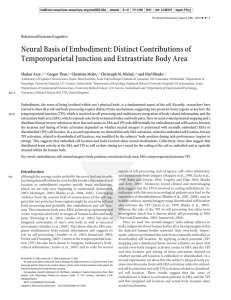The extrastriate body area (EBA): One structure, multiple functions?
advertisement
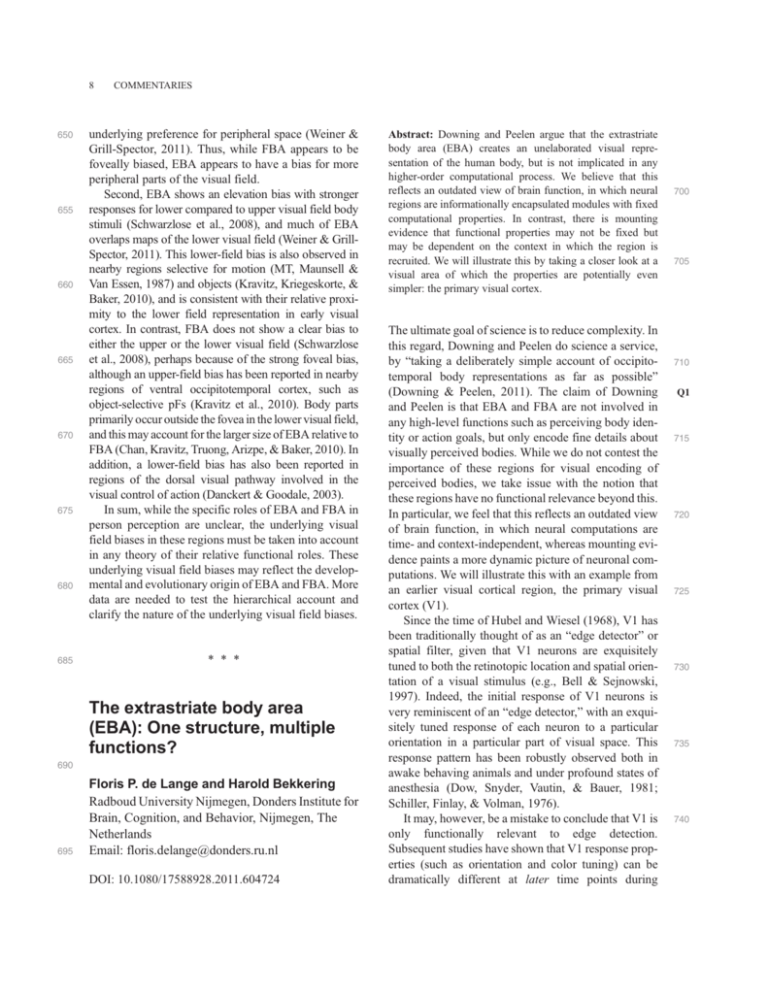
8 650 655 660 665 670 675 680 685 COMMENTARIES underlying preference for peripheral space (Weiner & Grill-Spector, 2011). Thus, while FBA appears to be foveally biased, EBA appears to have a bias for more peripheral parts of the visual field. Second, EBA shows an elevation bias with stronger responses for lower compared to upper visual field body stimuli (Schwarzlose et al., 2008), and much of EBA overlaps maps of the lower visual field (Weiner & GrillSpector, 2011). This lower-field bias is also observed in nearby regions selective for motion (MT, Maunsell & Van Essen, 1987) and objects (Kravitz, Kriegeskorte, & Baker, 2010), and is consistent with their relative proximity to the lower field representation in early visual cortex. In contrast, FBA does not show a clear bias to either the upper or the lower visual field (Schwarzlose et al., 2008), perhaps because of the strong foveal bias, although an upper-field bias has been reported in nearby regions of ventral occipitotemporal cortex, such as object-selective pFs (Kravitz et al., 2010). Body parts primarily occur outside the fovea in the lower visual field, and this may account for the larger size of EBA relative to FBA (Chan, Kravitz, Truong, Arizpe, & Baker, 2010). In addition, a lower-field bias has also been reported in regions of the dorsal visual pathway involved in the visual control of action (Danckert & Goodale, 2003). In sum, while the specific roles of EBA and FBA in person perception are unclear, the underlying visual field biases in these regions must be taken into account in any theory of their relative functional roles. These underlying visual field biases may reflect the developmental and evolutionary origin of EBA and FBA. More data are needed to test the hierarchical account and clarify the nature of the underlying visual field biases. * * * The extrastriate body area (EBA): One structure, multiple functions? 690 695 Floris P. de Lange and Harold Bekkering Radboud University Nijmegen, Donders Institute for Brain, Cognition, and Behavior, Nijmegen, The Netherlands Email: floris.delange@donders.ru.nl DOI: 10.1080/17588928.2011.604724 Abstract: Downing and Peelen argue that the extrastriate body area (EBA) creates an unelaborated visual representation of the human body, but is not implicated in any higher-order computational process. We believe that this reflects an outdated view of brain function, in which neural regions are informationally encapsulated modules with fixed computational properties. In contrast, there is mounting evidence that functional properties may not be fixed but may be dependent on the context in which the region is recruited. We will illustrate this by taking a closer look at a visual area of which the properties are potentially even simpler: the primary visual cortex. The ultimate goal of science is to reduce complexity. In this regard, Downing and Peelen do science a service, by “taking a deliberately simple account of occipitotemporal body representations as far as possible” (Downing & Peelen, 2011). The claim of Downing and Peelen is that EBA and FBA are not involved in any high-level functions such as perceiving body identity or action goals, but only encode fine details about visually perceived bodies. While we do not contest the importance of these regions for visual encoding of perceived bodies, we take issue with the notion that these regions have no functional relevance beyond this. In particular, we feel that this reflects an outdated view of brain function, in which neural computations are time- and context-independent, whereas mounting evidence paints a more dynamic picture of neuronal computations. We will illustrate this with an example from an earlier visual cortical region, the primary visual cortex (V1). Since the time of Hubel and Wiesel (1968), V1 has been traditionally thought of as an “edge detector” or spatial filter, given that V1 neurons are exquisitely tuned to both the retinotopic location and spatial orientation of a visual stimulus (e.g., Bell & Sejnowski, 1997). Indeed, the initial response of V1 neurons is very reminiscent of an “edge detector,” with an exquisitely tuned response of each neuron to a particular orientation in a particular part of visual space. This response pattern has been robustly observed both in awake behaving animals and under profound states of anesthesia (Dow, Snyder, Vautin, & Bauer, 1981; Schiller, Finlay, & Volman, 1976). It may, however, be a mistake to conclude that V1 is only functionally relevant to edge detection. Subsequent studies have shown that V1 response properties (such as orientation and color tuning) can be dramatically different at later time points during 700 705 710 Q1 715 720 725 730 735 740 COMMENTARIES 745 750 755 760 765 770 775 780 785 790 perceptual inference (Lamme & Roelfsema, 2000). These changes in response profile, which are likely due to feedback (and possibly horizontal) connections to V1, suggest that V1 computations may be different at different time points. Indeed, computational models of perceptual inference suggest that while early activity in V1 may simply reflect feature detection, at a later stage V1 may actively participate in multiple visual routines such as object reconstruction and completion (Lee, Mumford, Romero, & Lamme, 1998). Indeed, later activity in V1 appears to reflect the perception of illusory contours in Kanisza-like figures, where no physical line is present in the neuron’s receptive field (Lee & Nguyen, 2001), and it has even been argued that feedback to V1 is necessary in order to become aware of a visual stimulus (Lamme, 2006; PascualLeone & Walsh, 2001). Finally, a recent study provides compelling evidence for a potential role of V1 in working memory, when a visual stimulus had to be held online for a prolonged period of time while the stimulus is not physically present (Harrison & Tong, 2009). Considering all the evidence, the label of V1 as an “edge detector” may at best be an incomplete characterization of this cortical module. While this label may correctly describe the function of this node at an early stage of the cortical computation, when receiving information from the lateral geniculate nucleus in the thalamus, its response properties and thereby putative computational role appear to change at later stages when it receives input from other areas that are higher in the cortical hierarchy. The same argument may well pertain to the EBA and FBA. There is indeed good evidence of these regions’ involvement in the encoding of fine details of bodies (Downing, Jiang, Shuman, & Kanwisher, 2001), just as there is good evidence of the involvement of V1 in encoding orientation and contrast of line stimuli (Hubel & Wiesel, 1968). But there appears equally good evidence of the modulation of activity of these regions by more high-level factors. Indeed, Downing and Peelen describe several cases in which EBA/FBA activity is modulated by higher-level factors. They interpret these activity modulations as “attentional feedback to occipitotemporal cortex” (p. 30). However, as we have seen with the example of V1, activity modulations by feedback may subserve much more complex processing than simply “boosting the representation,” and may alter the representation itself. The activity of V1 to an illusory (Lee & Nguyen, 2001) line is “cognitively elaborated,” in the sense that 9 it does not passively represent “what the eyes tell,” but rather what is in “the mind’s eye.” It may be equally incorrect to refer to the representation in EBA as “cognitively unelaborated.” Perhaps the most striking examples of top-down influence on EBA are provided by motor control studies, in which no visual stimulus of a body part were presented, yet where robust EBA activity is sometimes observed (Astafiev, Stanley, Shulman, & Corbetta, 2004; Kuhn, Keizer, Rombouts, & Hommel, 2011; Zimmermann, Meulenbroek, & de Lange, 2011). This situation is reminiscent of the aforementioned study by Harrison and Tong (2009), where, in the absence of any physical stimulus, V1 contributes to holding online a perceptual representation. We believe that EBA may have a similar role in motor control, in terms of holding online a visual representation of the goal state of an action. While this does not contest a role of EBA in representing bodies, it does not render the region irrelevant to motor planning. A crucial test of the necessity of this region in action planning should come from intervention studies, such as lesion studies or TMS. Indeed, a patient study observed deficits in motor planning following lesions of the ventral occipitotemporal cortex (Dijkerman, McIntosh, Schindler, Nijboer, & Milner, 2009), though the relative lack of specificity precludes a straightforward interpretation. Importantly, TMS studies that aim to show the (ir)relevance of EBA to motor control should bear in mind the potential dynamic nature of the computations in EBA, possibly by targeting this area at different stages of the planning process (cf. Pascual-Leone & Walsh, 2001). We believe that this could be a fruitful area of future research. 795 800 805 810 815 Q2 820 825 830 * * * Functional and epiphenomenal modulation of neural activity in body-selective visual areas Cosimo Urgesi1 and Alessio Avenanti2 1 Dipartimento di Scienze Umane, Università di Udine; and Istituto di Ricovero e Cura a Carattere Scientifico “Eugenio Medea,” Polo Friuli Venezia Giulia, Italy 835 840
